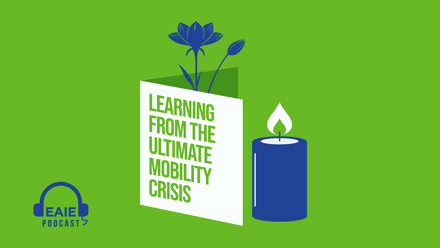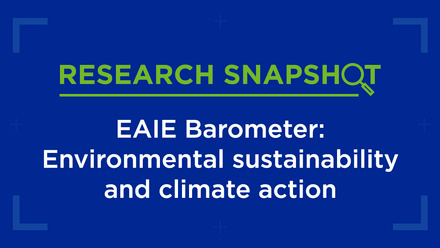International education’s need for a strategic environmental assessment

As our global climate continues to change, growing warmer and less hospitable to human habitation, perhaps it is not surprising that the climate of international education is changing with it. The 2022 Spring edition of EAIE Forum magazine engages with the theme of ‘Our changing climate’ to explore the multi-faceted relationship between international education and the climate crisis. Kicking off the launch of this newest edition of Forum, today’s blog looks at how a "strategic environmental assessment" might nudge international education in a more climate-friendly direction.
In 2019, Justin Trudeau’s government launched Canada’s second international education strategy (2019–2024), aimed primarily at supporting Canadian students to go abroad in larger numbers to address the gap in global skills and knowledge. The strategy has a target of sending 11,000 Canadian students abroad, particularly in key global markets such as Asia and Latin America. To implement the strategy, the Canadian federal government allocated $147.9m over five years, followed by $8m per year of ongoing funding. The key elements of the strategy include an investment of $95m over five years to finance outbound student mobility pilot initiatives. Of that amount, half of the funds in the pilot will support equal access to international mobility opportunities for underrepresented groups of students, including low-income students, Indigenous students and students with disabilities.
At the same time, there are rising concerns among international education practitioners and scholars about the environmental impact of outbound mobility programmes. While the Canadian strategy is praiseworthy for its commitment to equity and inclusion, little attention has been paid to the environmental impact of student mobility. In a 2010 cabinet directive, the Ministers asked all federal government departments to include a strategic environmental assessment with any plan, policy or programme proposal that requires their approval if the implementation of the proposal may have environmental effects. In this article, I argue that the federal government of Canada should begin to take environmental concerns into account when developing its strategy for the international education sector.
Considering our climate
The Canadian federal government’s international education strategy 2019–2024 does not address how air travel involved in outward student mobility would contribute to the global climate crisis. According to Laura Rumbley in a 2020 article for International Higher Education, student mobility is "highly damaging to the planet". For her argument, she presented a recent study published in the Journal of Cleaner Production, which found that global greenhouse gas emissions associated with international student mobility were between 14.01 and 38.54 megatons of CO2 equivalent per year in 2014. This is a substantial emission since recent reports on the global climate crisis highlight the urgent need to reduce carbon emissions and levels of greenhouse gases in the atmosphere. In an article for the Winter 2019 edition of EAIE Forum magazine, Pii-Tuulia Nikula, one of the founders of the Climate Action Network for International Educators (CANIE), called for action and more research on the impact of internationalisation on climate change, and possibility towards a carbon-neutral future for the international higher education sector.
From a climate perspective, instead of only increasing students' mobility, more attention needs to be paid to Internationalisation at Home
While the federal government of Canada is keen to send students for outbound mobility programmes to realise Canada’s economic interest in Asia and Latin America, there is emerging literature suggesting that international education practitioners should look for alternatives. According to de Wit and Altbach, higher education institutions and funding agencies should reduce and restrict "short-term mobility to those forms of mobility that are climate neutral: using fewer flights". Others have called for "doing more global learning locally"; as de Wit and Altbach argue, since Western countries like Canada have a diverse population, Canadians really do not need to go far away to meet the ‘other’. From a climate crisis perspective, instead of only increasing students' outward mobility, more attention needs to be paid to Internationalisation at Home, which includes internationalising the curriculum and engaging in collaborative online international learning or virtual exchanges of ideas. The literature also calls for further studies on balancing international education and its environmental impact.
According to Ilieva et al, "If we apply the common-sense rules of environmental sustainability and energy consumption to international education, by every definition international education is unsustainable in terms of the academic mobility (and energy consumption) it promotes". On the other hand, the Canadian federal government wants to send more of its citizens to study abroad to increase employability and global connection of Canadian youth. According to Hale, we must assess the environmental cost of trying to increase global connection of Canadian youth through outbound study abroad programmes.
Local and global solutions
A strategic environmental assessment like the one called for in the 2010 directive would have contributed to the development of the international education strategy on an equal basis with economic or social analysis. This would have assured all stakeholders that environmental factors have been appropriately considered when the strategy was developed.
I am not advocating to end the outbound mobility programmes altogether; the climate crisis is a global issue that requires global solutions
I am not advocating to end the outbound mobility programmes altogether; the climate crisis is a global issue that requires global solutions. Such global solutions will only come from locals of each country, and all local citizens need to speak to each other about how they are mitigating the adverse effects of climate change. Outbound mobility programmes in combination with virtual and/or in-person study abroad programmes will provide learners the opportunity to speak and hear from each other about this global and local issue. To that end, the federal strategy could have allocated some of the $95m investment to mitigating the environmental impact of Canada’s outbound student mobility programmes. This would have given higher education institutions much-needed information on how to develop sustainable mobility programmes. Since the strategy is now in the implementation stage and the first round of federal funding has been allocated, Canadian universities have the opportunity to develop study abroad programmes in a way that promotes dialogue on the climate crisis with various locals where students are sent to learn and engage. Since there is substantial environmental concern surrounding study abroad programmes, the federal government of Canada should conduct a strategic environmental assessment on international education itself.






